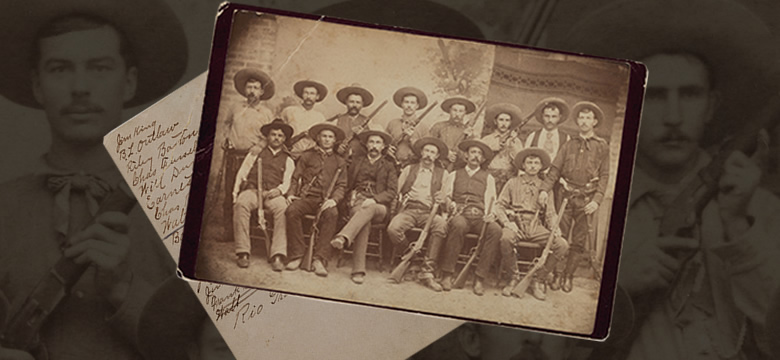
I’m a native Texan through and through. I was born and raised in the Dallas-Fort Worth area, I went to school here, and now I’m raising my children here. Growing up in Texas, it’s hard not to be inundated with tales of the Old West. Westerns were a mainstay in my house growing up.
I devoured the works of Louis L’Amour and Zane Grey. Saturday and Sunday afternoons found me glued to the television watching old episodes of The Lone Ranger, The Rifleman, Alias Smith and Jones, Rawhide. When I was very young, I proudly wore my (plastic) six shooter and Lone Ranger mask. But nothing fascinated me more than tales of the Texas Rangers. First let me provide a little background on the Rangers.
The story begins some two years after Anglos from the United States began colonizing Mexican Texas, around 1823. Stephen F. Austin, the namesake of the state’s capital, hired ten men to function as rangers against marauding Indians, but it was not until the Texas Revolution (specifically on November 24, 1835) that an actual force was established bearing the name Texas Rangers. They fought in the Texas Revolution, the Mexican War, the Civil War, and even the Mexican Revolution during the early years of the twentieth century. Rangers protected the frontier from all manner of dangers. An interesting side note, in the early days they also functioned as land surveyors while out in the field. Men such as John Coffee “Jack” Hays, Samuel Walker, William A.A. “Bigfoot” Wallace, and John Salmon “RIP” Ford became legends.
In the decade following the Civil War, Texas was plagued with attacks by the Comanche and Kiowa, bandidos from Mexico bent on thievery, and general misbehavior by outlaws such as Sam Bass and the notorious John Wesley Hardin. In 1874, the Texas Legislature reorganized the Rangers into six companies known as the Frontier Battalion. By the late 1880s, the Battalion was reduced to only three companies – B, D, and F. This provides a nice segue into the purpose of this blog entry.
At this Saturday’s (June 14, 2014) Legends of the West sale, we are offering an 1888 photograph of the men of Company D. Included in the photograph is one J. Walter Durbin, one of the more famous Frontier Battalion-era Rangers.

I should probably provide a little background info on the photograph itself. It was taken in Rio Grande City, Texas (located on the Mexican border about 40 miles from McAllen), in November 1888. Several famous faces accompany Durbin including his brother, Tink Durbin, Capt. Frank Jones, Bass Outlaw (who was killed six years later in a gunfight where he murdered fellow Ranger Joe McKidrict in a drunken stupor), Cal Aten, and Frank Schmid (who sustained a fatal gunshot wound the year after this picture was taken, though he lingered on another four years). Each of the men is identified on the reverse.
What is unique about this photograph (aside from its marvelous condition) is the history behind it. This cabinet card has been passed down from Walter Durbin through four generations to his great-granddaughter. I caught up with her and she was kind enough to provide some family history with me, a portion of which I will share with y’all:
 How old were you when you first learned about your great-grandfather’s exploits on the Texas frontier? “I was around nine or ten years old and my grandmother, Julia, (aka Mimi) Durbin Koehler, would show me some of her great old pictures from when she lived in Pearsall, Texas. Julia only had one child, my mom, Olive Estelle Koehler. Julia’s father, Walter Durbin was sheriff in Pearsall [after his retirement from the Rangers], had several horses and my mother Olive learned to ride and shoot very well as a teenager growing up there.”
How old were you when you first learned about your great-grandfather’s exploits on the Texas frontier? “I was around nine or ten years old and my grandmother, Julia, (aka Mimi) Durbin Koehler, would show me some of her great old pictures from when she lived in Pearsall, Texas. Julia only had one child, my mom, Olive Estelle Koehler. Julia’s father, Walter Durbin was sheriff in Pearsall [after his retirement from the Rangers], had several horses and my mother Olive learned to ride and shoot very well as a teenager growing up there.”
How did the photograph come to be in your possession? “When I was fifteen or sixteen, I was still living at home, taking care of my grandmother after school each day. She was very interested in talking about when she grew up in Texas. . . . She left all of her pictures to my mom and me.”
Can you recall any stories or family legends your mother or grandmother told you regarding Durbin? “My grandmother Julia said he was always nicely groomed and had southern manners; very polite to people. He had a quiet sense of humor and would sometimes tell young kids wild stories about his cowboy and Ranger days. He preferred to arrest whoever if he could, instead of having to shoot them, a last resort only she told me. He treated his prisoners out on the prairie fairly well, fed them on the way to taking them to jail.”
What about his wife? “His wife, Mollie, could ride and shoot as well as any man.”
He sounds like a fascinating man. He had a brother, Tink, who was also a Ranger and is featured in the photograph. Any other siblings? “Walter Durbin had two brothers . . . they all had a good religious background growing up. He also had one sister, May, who later moved to San Francisco. Elisha [one of the brothers] was a deputy sheriff and owned a printing office for the Denton County News, a serious and very quiet, good man, everyone said. . . . His youngest brother, Will “Tink” Durbin was a Texas Ranger also in Co. ‘D’ and deputy sheriff in Denton County. Later he returned to operate a saloon in Denton and Lewisville.”
What did Durbin do after he left the Rangers? “While a sheriff in Pearsall, Walter also owned a saloon and billiard hall. As a young man he worked on farms, was good at carpentry, and later became a Texas Ranger. He . . . had three children: Julia (my grandmother), Marshall, and Herman. Durbin kept detailed accounts of his times with the Rangers. He loved poetry and loved to read. In 1916, at age 56, he passed away after suffering from a very bad case of poison oak.”
By Bryan Booher


I thought this was an interesting story on some potential relatives. I would love to learn more about that side of the Durbin Family
I’m tracy durbin from kentucky. In the mid 1800 family broke up a lot went to Texas, San Antonio, area we have a long line of law enforcement I wonder if Walter durbin was some relation . Interesting story interesting find
I jave been researching my wife’s family from Pearsall. Her greatgrandfather was Gabe Hans. Durbin’s sherriff’s office was above his saloon. Every morning Durbin would stop for a drink before going upstairs. Gabe saw him shoot the editor of the paper. He said the truth would come out when they went to Laredo for the trial. Before the the trial began Durbin’s friend, Jim Gray, came to his house to offer an olive branch on behalf of the sheriff. The next morning they found Gabe in an alley with his throat slit and Jim Gray gone. Eight years later Gray was found in an alley in Del Rio with his throat slit. So happened that Gabe had a brother who owned a saloon in Del Rio. All of this is documented from the San Antonio newspaper archives.
WOW!
My GrGr Grandfather Albert M. Handly was a Ranger in 1885 and was in company of Durbin in action events. He is mentioned in some of the stories. I think they spelled his name Handley perhaps.
My grandma Ruby K. Roberson Wynn, recognized her uncle “Jim Robinson” from this photo, when I showed it to her from one of the western magazines from the 1960’s. Jim’s brother, David Seth Roberson, served in the Frontier Battalion, from the 1870’s- till the Rangers were reorganized in 1900. Their nephew, my g-grandpa Thomas H. Roberson, served in Co E, Frontier Battalion, when it was stationed in Alice, Texas
God Bless The Texas Rangers and All the Brave Men and Women who have served honorably in the Law Enforcement Agencies all Around Our Great Nation since it’s inception. Thank You for your Service.
I wonder how he met his wife Molly, and I guess they didn’t think about how Herman Durbin would like his matching names! LOL! He was a very handsome man. I love his mustache and am saddened to think that after all his rootin-tootin days of being a Texas Ranger, that he did so young and of all things, poison oak, but those were the days before antibiotics so a lot of medical problems could kill you. My Great Grandmother born in 1896 lost a daughter at 9 from scarlet fever, and her only son at 16 from a burst appendix. It’s fascinating to read the history behind these wild lawmen of the west!